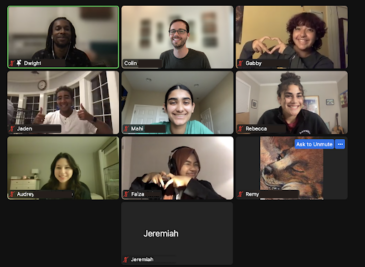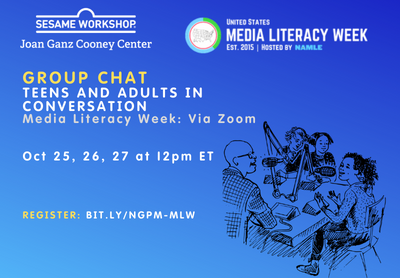This summer, 10 teenagers from around the country joined the Cooney Center for our first-ever Next Gen Public Media Youth Fellowship. The cohort met every other week throughout the summer to build community and prepare for events that the Cooney Center hosted in the Next Gen Public Media initiative. Over the course of the summer, youth fellows were guests in a Peer Learning Community meeting, panelists in a workshop, and discussants in our “Group Chat” webinar series (being released this fall). Through our partnership with this group of teens, we learned first-hand about the issues that they care about, how they want to approach them, and what adults often misunderstand. As a result, youth perspectives directly shaped each of these public events and the Next Gen Public Media initiative at large.

But what happens next? We wanted to give the youth fellows a platform that could reach beyond summer 2022 and the participants who were able to join us in real time. So we turned a question over to the youth fellows: what are the most important topics we addressed this summer, and what would you like people to know about them?
Here are some of the key takeaways:
Youth fellows generally believe that there is an increasing amount of cultural and racial diversity represented in media content, but it is still somewhat limited and sometimes comes across as tokenism.
Jaden (16, Massachusetts) feels that “There is so, so much more work and room to grow in this topic. Just because there is a little bit of diversity in [some] media does not mean that there is enough diversity at all in the media world.” Mahi (16, California) has experienced the failings of representation in media firsthand. She describes how it is a problem that she has personally faced, and one that faces her peers more broadly: “As a South Asian female athlete, I see a lot of misrepresentation of both my race and gender in the media. Through the youth fellowship, I learned the struggles of people from other backgrounds and the struggles they face in media too. I hope people understand how much still needs to be done to have accurate media representations.”
Jeremiah (17, Georgia) agrees, and wants readers to know that the path forward needs to go beyond tokenism. “Creating media that includes diversity is more than just adding a token character of color, or characters with different beliefs. To be truly diverse is to use these characters in ways that are relatable and that are uncommonly used… [Creating] media that shows [diverse kinds of] people as normal is a step in the right direction. The world would be greatly impacted if we see characters not only embody the culture they represent but still interact like normal youths would.”
There is something uniquely valuable to young people about having their perspectives shared on a broader platform.
Faiza (16, Maryland) describes what’s important about having a platform, and about ways that public media can do that in better ways than social media: “There is a reason why many youth may feel safer broadcasting their own opinions online, as it is one of the only platforms that can help their voice reach other like-minded youth, creating a bond stronger than the criticism that may come from adults about our current state in our world. These perspectives, whether virtual or in-person, are critical for a better understanding of our world. We are the future and the new generation that will help implement change through new ideas and productivity, but we primarily need a platform to broadcast our ideas and thoughts.”
Mahi agrees: “Giving a voice to youth in spaces of public media can impact young people in a variety of ways. Through discussions with the other youth fellows, I realized that many people use social media as a platform to speak out about issues, since they are not always given a voice on mainstream media platforms. However, the unethical design of social media, whose primary goal is to keep teens addicted to their screens, does not always create the best environment for teens to be spending their time. Giving them a voice on a larger platform, such as public media, can help them feel heard in front of a larger audience.”
Mental health and well-being is a critically important topic for teens.
Youth fellows believe there needs to be more dialogue around mental health in ways that reflect the diversity of experiences teens have. Gabby (18, Pennsylvania) underscores the importance of authenticity when talking about mental health with youth:
“I used to think it was just me who felt this way until I started having conversations with those within the fellowship. It was interesting to see how disconnected youth, including myself, were from mental health discussions. I was also captivated at how everyone found different ways of learning about mental health that resulted in doing our own research or watching videos on YouTube, TikTok, etc. The way we are taught about mental health is different from how we actually deal with it.
Mental health shouldn’t be a white-centric conversation, and many times it is. It’s hard to connect with something or talk about something when it doesn’t come from your own community’s background. Mental health can be very taboo in certain cultures or religions. Talking about generational trauma, depression, suicide and much more all depend on the way you were raised or the standards of your community. It’s different for everyone and that difference is not taken into account.
With that cultural divide, there is then a generation divide. It’s hard for an adult to fully understand our thoughts. Oftentimes the videos we see in class about mental health come across as “fake” or “staged” and sometimes it feels that our thoughts aren’t listened to. These conversations need to be more youth-led and have more youth perspectives from different backgrounds.
It’s sad to see how many of these conversations end up and how many teens stopped listening to them.
When it comes to mental health, we need to be more engaging with youth. If there was more engagement, more youth-led discussions, more spaces that felt safe, I feel that mental health could be a topic that is properly taught about. The world could be different if youth became more involved.”
Online culture is an important part of teens’ everyday experiences both for better and for worse. But the ways that reality gets distorted online, and teens compare themselves to those distortions, can be difficult to bear and difficult to change.
Rebecca (15, Virginia) describes some of her experiences, both positive and negative: “People are able to connect on such a variety of subjects and form very real, personal connections, even though they are online. Just because a connection is made over the internet, doesn’t mean that the relationship is any less than a relationship formed face to face. Realistically, I don’t think that social media will ever go away, or stop being ‘highlight reels’ of people’s lives. However, I do think that we should change our view of social media. We should just view it as a place where people can share their happy moments, rather than a place where people are vying for likes and attention.”
Making this kind of change is hard. As Remy (17, Tennessee) described it, “Body image isn’t the only way reality is distorted online and in media. Which reactions and consequences are seen as acceptable online are different from the ones many people would think are acceptable in real life, and most people put on some sort of front online. The scale of things online will likely always be very different from how it is in real life, and I don’t know how to fix that.”
Audrey (17, Virginia) describes her own experience working on making this change, while acknowledging that it’s difficult to do, and hard on kids in the meantime: “Kids are just too young to realize that what they see online isn’t reality. Once I learned that the images I was seeing were often altered or idealized versions of someone’s life, I dropped many of my insecurities. [But still] today I compare myself to other people online and feel as if I can’t be happy if my life isn’t a certain way. I always want my life to be more productive, more fun, and more ‘aesthetic.’ At the end of the day, I just want to learn how to live happily in the moment instead of constantly comparing everything in my mind.”
Youth culture online is complex; so is the part of it that we call “cancel culture.” Youth fellows make a distinction between the kind of transgressions made by people in power, who may “deserve” to be “canceled,” and the kind of mistakes that they and their peers make, which deserve a chance for learning and growth.
Grace (16, Wisconsin) believes that, “Most of cancel culture is very, very toxic to be living through, and as a general rule I think it’s best to communicate instead of shun. ‘Canceling’ practices are inherently anti-education. Most people who end up getting canceled, ‘influencer’ or not, are very young. The way to teach a young person isn’t to shame them – that will only end in festering hatred. To educate them and invite them to learn from their mistakes, a dialogue is imperative. In the current social media climate, there is no room for that. From my perspective, I think the dialogues online should be focused towards kindness and mutual understanding instead of shame – it’s difficult because the current political climate is so polarizing, but an important step to making it less so is to make this online change.”
Gabby agrees, and elaborates on the complexity of this cultural norm, which has “no in-between”: “There are things that people should be canceled for and there are wrongs that people should know not to do. There are many celebrities that deserved to be canceled as well. But when you start focusing on teens in high school, who grew up in different environments, different norms, this is where issues arise. I’ve always been a person who wants to get all sides of the story and wants to talk things out. With cancel culture, it has created a way to isolate someone for mistakes they have made and expose them over social media. It’s something that could either be fully aggressive or kind-of light — no in between. Cancel culture needs to have more possibilities of discussion and teaching. When you teach someone what they did was wrong, that opens up growth, and growth opens up more possibilities then just shutting someone out.”
There’s so much more to learn. These five takeaways are just a few of the youth fellows’ insights that have shaped our efforts to work by/with/for youth. For more, check out our recent research briefs and tune into our upcoming webinars:
- Research brief: “Models of Youth-Adult Collaboration for Public Media” (published April 2022)
- Research brief: “Understanding Youth: A Prerequisite for Creating Programs By/With/For Tweens and Teens” (published June 2022)
- Research brief: “Content and Platform Innovation with Youth” (published September 2022)
- “Group Chat: Youth Digital Culture” (coming October 2022)
- “Group Chat: Adolescent Wellbeing Online” (coming October 2022)
- “Group Chat: Youth Creators in Public Media” (coming October 2022)



